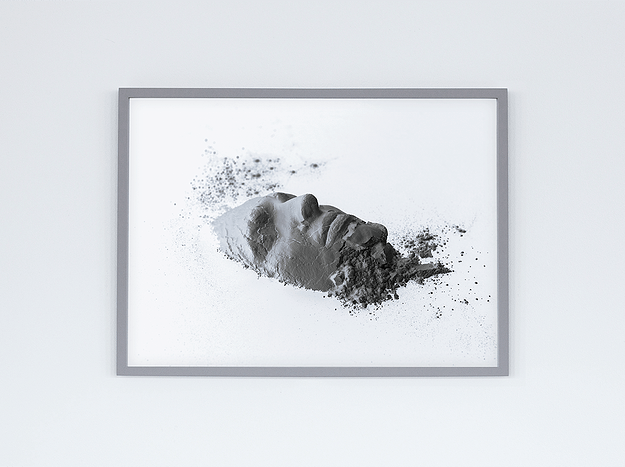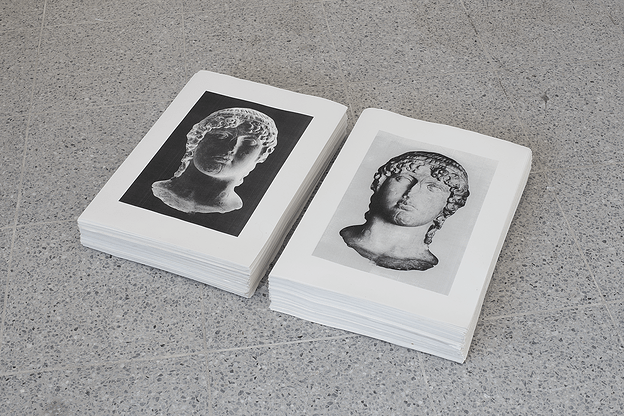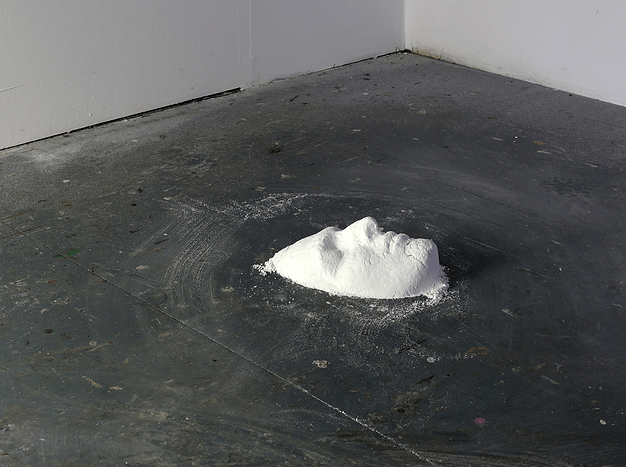AN IMPOSSIBLE TASK — JAMES WILLIAM MURRAY
by Seán Padraic Birnie
27.01.2016

Before her lover departs, she traces his shadow, thrown by candlelight, on to the wall.
Later her father, the potter Butades, will make a cast from the drawing.
In the Natural History, Pliny locates the origins of art, of the graphic and plastic arts, in the trauma of romantic loss. As a way of staving off a future loss and as a form of compensation once it has passed. The question of contact and of touching plays a determinate part in proceedings: the present lover directly casts his shadow; the young woman directly traces his shadow; her father fashions his sculpture directly from the trace. A certain connection threads through each medial layer. So art begins with the shadow of its subject, its ghost or shade, a derivative effect. Something primary and vital is lost; the work of art exists in a condition of secondarity, surrogacy, derivation. The myth establishes the question of medium, too, of the limitations that enable and disable in unequal measure: sculpture, which takes drawing as its model; and how the shift into three dimensions from the original tracing becomes a more powerful invocation of presence. In this sculpture fulfills a promise that drawing makes but cannot honour. It becomes something you can touch. It becomes something you can hold, and thereby compensates, or for a time seems to compensate, for the inadequacy of the two-dimensional image. It replaces the shadow of the man with the shadow of the sculpture. The sculpture, as the fulfillment of this process, as a tactile thing occupying space in the world, becomes a surrogate for the lover and the lost sensuality of love.

But in its fulfillment of that promise it risks a deeper betrayal: the truest likeness becomes the greatest travesty. Instead of summoning that presence, it casts the absence into sharp relief. What aspired to compensate becomes a taunt. The likeness simulates presence, but in the very efficacy of its simulation throws a harsh light on the facts of distance and future-loss. Photography, in which the automatic apparatus secures a form of homological likeness unparalleled in the other depictive arts, exacerbates this logic. Every photograph is this catastrophe, as Barthes says of the picture of Lewis Payne, shortly before his execution. For the Hungarian photographer Brassaï “...the question is always to find that sole translation that will be valid in another language... for all literal translation is treason.” The medium’s fidelity to surfaces enables the illusion that one might enter the picture, that the image plane hoards depth, forever just out of reach. The desires photography sets in motion (and the very desire which set photography into motion) animate the belief in that illusion (and we know it is an illusion, of course, we are not naive: nevertheless, the precision secures our belief, in spite of that knowledge), which works only at a certain distance: nose against print or screen, the image breaks up, becomes grain or noise. Becomes a hard surface. What at first seems to put you into touch becomes at last a barrier.
In photographs and partial sculptures, Beheld explores these barriers. One might go further and say that the essence of the work does not reside in the individual pieces, but in their interrelationships, and in the primary relationship Beheld supplants, that of lover and the beloved, artist and subject. The work finds its starting point and aesthetic logic in the myth of the Corinthian maid. Tease out the meanings that its title set in play: to hold and to touch, most obviously. To possess and be possessed; the eye of the beholder (and the failure of photography’s optical regime), a later addition in English to the Germanic compound. In relation to its combination of different media, the way a medium holds, or tries to hold, its subject. The term always contains this sense of potential loss: one only need hold on to something that can be taken away. Hold still – like a sculpture – for a photograph. Hold back. Contain, like a frame, or like a medium. That containment necessarily fails, and it is this failure that seems to me to be the key to the way that Beheld works. The subject – any subject – will always exceed its form: the translation of which Brassaï speaks is always an abstraction, a reduction. There is no lossless medium. Condemned to an impossible task, the problem becomes one of doing justice to the subject, to the subject’s overflowing excess: in the interstices between its components – digital photographs on tracing paper; a sculpture in marble dust; stills from an unshown video recording the attempt to draw a perfect circle – that excess returns in spectral from: a product of spatial relationships, of incomplete processes, unfinished things. That form does not become visible or tangible, and in this way it eludes the violence of reduction. Instead it hovers in the gaps.

The likeness in marble dust is from a direct mold of the subject’s face (Andre Bazin likens photographs to a death mask, molded from that face). It’s a temporary sculpture, reformed for every showing. The delicacy of the thing solicits the desire to touch, but of course to touch it would be to destroy the likeness, would dislodge its precarious shape. Like a reflection in water – touch the surface and the splash disrupts the image. In a reversal of the shift, in the Corinthian Maid myth, from the graphic image to the plastic form, the sculpture in its turn becomes the subject of a photograph, fixing that precarity in the stillness of the picture. It is a photograph of the sculpture, but not of this sculpture, the one here on the floor, but an earlier point in the series of temporary sculptures made for each showing of the work. Possibly the original sculpture, though what status accrues to an original is rather thrown into question. But in the studio now the two works, sculpture and photograph, photograph of an earlier form of the present sculpture, vie for primacy in a struggle without resolution. Perhaps that irresolution in itself is the point: this skein of mediations, from body to shadow to tracing to cast to sculpture – when the lover departs, only this tangle of shadows and shadows of shadows remains.

info@ardesiaprojects.com